Friction and Wear Properties of Silicon Nitride-Based Composites with Different hBN Content Sliding against Polyether-Etherketone at Different Speeds under Artificial Seawater Lubrication
Abstract
:1. Introduction
2. Experimental Procedures
2.1. Preparation of Specimens
2.2. Procedure
3. Results and Discussion
4. Conclusions
- Under an artificial seawater environment, the friction and wear performance of Si3N4-hBN/PEEK pairs was affected by the sliding speed. With the hBN content increased from 5% to 20%, the friction coefficients and wear rates decreased with the increase in sliding speed. With hBN contents of 0 and 30%, the sliding pairs represented an upward trend as the speed increased. Meanwhile, the lowest friction coefficient of 0.07 and wear rates below the magnitude of 10−6 mm3/Nm were obtained for the SN20/PEEK pair at a sliding speed of 1.73 m/s.
- When the SN20 pin slid against the PEEK disc, the tribofilm was gradually formed on the wear surface in seawater, which was mainly due to the higher flash temperature and less wear debris produced by the increase in speed. When the friction resistance of the sliding pair mainly came from the shear strength of soft tribofilm, the sliding pair entered a state of low friction and wear.
- When the SN0 pin slid against the PEEK disc, no tribofilm formed on the wear surfaces, and part of the friction resistance was from the mechanical meshing, resulting in higher friction and wear. Simultaneously, the increase in speed aggravated the frequent plowing and mechanical meshing. For the SN30/PEEK pair, severe deterioration of the mechanical properties caused an extremely rough wear surface with more serious mechanical wear. Once the speed increased, the mechanical meshing became more severe under the action of shear force.
Author Contributions
Funding
Institutional Review Board Statement
Informed Consent Statement
Data Availability Statement
Conflicts of Interest
References
- Zhao, J.; Han, B.; Cui, G.; Zhang, S.; Li, M.; Wang, Y. Preparation of Ni55 + FeS composite coatings and their antifriction performances in artificial seawater. Mater. Des. 2017, 131, 375–383. [Google Scholar] [CrossRef]
- Haq, M.I.U.; Raina, A.; Vohra, K.; Kumar, R.; Anand, A. An Assessment of Tribological Characteristics of Different Materials under Sea Water Environment. Mater. Today Proc. 2018, 5, 3602–3609. [Google Scholar] [CrossRef]
- Ma, F.; Li, J.; Zeng, Z.; Gao, Y. Structural, mechanical and tribocorrosion behavior in artificial seawater of CrN/AlN nano-multilayer coatings in F690 steel substrates. Appl. Surf. Sci. 2018, 428, 404–414. [Google Scholar] [CrossRef]
- Liu, X.; Zhao, X.; An, Y.; Hou, G.; Li, S.; Deng, W.; Zhou, H.; Chen, J. Effects of loads on corrosion-wear synergism of NiCoCrAlYTa coating in artificial seawater. Tribol. Int. 2018, 118, 421–431. [Google Scholar] [CrossRef]
- Ye, Y.; Wang, Y.; Ma, X.; Zhang, D.; Wang, L.; Li, X. Tribocorrosion behaviors of multilayer PVD DLC coated 304L stainless steel in seawater. Diam. Relat. Mater. 2017, 79, 70–78. [Google Scholar] [CrossRef]
- John, M.; Menezes, P.L. Self-Lubricating Materials for Extreme Condition Applications. Materials 2021, 14, 5588. [Google Scholar] [CrossRef]
- Cai, Y.; Yin, X.; Fan, S.; Zhang, L.; Cheng, L. Tribological behavior of three-dimensional needled ceramic modified carbon/carbon composites in seawater conditions. Compos. Sci. Technol. 2013, 87, 50–57. [Google Scholar] [CrossRef]
- Zhang, Y.; Yin, X.-Y.; Yan, F.-Y. Tribocorrosion behavior of type S31254 steel in seawater: Identification of corrosion–wear components and effect of potential. Mater. Chem. Phys. 2016, 179, 273–281. [Google Scholar] [CrossRef]
- Chen, M.; Kato, K.; Adachi, K. The Difference in Running-in Period and Friction Coefficient between Self-Mated Si3N4 and SiC Under Water Lubrication. Tribol. Lett. 2001, 11, 23–28. [Google Scholar] [CrossRef]
- Wang, S.; Cheng, J.; Zhu, S.; Qiao, Z.; Yang, J. Low friction properties of Ti3AlC2/SiC tribo-pair in sea water environment. Tribol. Int. 2016, 103, 228–235. [Google Scholar] [CrossRef]
- Wu, D.; Liu, Y.; Li, D.; Zhao, X.; Ren, X. The applicability of WC–10Co–4Cr/Si3N4 tribopair to the different natural waters. Int. J. Refract. Met. Hard Mater. 2016, 54, 19–26. [Google Scholar] [CrossRef]
- Fischer, T.; Tomizawa, H. Interaction of tribochemistry and microfracture in the friction and wear of silicon nitride. Wear 1985, 105, 29–45. [Google Scholar] [CrossRef]
- Saito, T.; Hosoe, T.; Honda, F. Chemical wear of sintered Si3N4, hBN and Si3N4–hBN composites by water lubrication. Wear 2001, 247, 223–230. [Google Scholar] [CrossRef]
- Gao, Y.-M.; Fang, L.; Su, J.-Y.; Xie, Z.-G. Investigation on the components and the formation of a tribochemical film in the Si3N4–gray iron sliding pair lubricated with distilled water. Wear 1997, 206, 87–93. [Google Scholar] [CrossRef]
- Skopp, A.; Woydt, M.; Habig, K.-H. Tribological behavior of silicon nitride materials under unlubricated sliding between 22 °C and 1000 °C. Wear 1995, 181-183, 571–580. [Google Scholar] [CrossRef]
- Liu, N.; Wang, J.; Chen, B.; Yan, F. Tribochemical aspects of silicon nitride ceramic sliding against stainless steel under the lubrication of seawater. Tribol. Int. 2013, 61, 205–213. [Google Scholar] [CrossRef]
- Zhang, Z.; Li, X.; Almandoz, E.; Fuentes, G.G.; Dong, H. Sliding friction and wear behavior of Titanium-Zirconium-Molybdenum (TZM) alloy against Al2O3 and Si3N4 balls under several environments and temperatures. Tribol. Int. 2017, 110, 348–357. [Google Scholar] [CrossRef]
- Wang, C.; Ye, Y.; Guan, X.; Hu, J.; Wang, Y.; Li, J. An analysis of tribological performance on Cr/GLC film coupling with Si3N4, SiC, WC, Al2O3 and ZrO2 in seawater. Tribol. Int. 2016, 96, 77–86. [Google Scholar] [CrossRef]
- Skopp, A.; Woydt, M. Ceramic and Ceramic Composite Materials with Improved Friction and Wear Properties. Tribol. Trans. 1995, 38, 233–242. [Google Scholar] [CrossRef]
- Carrapichano, J.; Gomes, J.; Silva, R. Tribological behaviour of Si3N4–BN ceramic materials for dry sliding applications. Wear 2002, 253, 1070–1076. [Google Scholar] [CrossRef] [Green Version]
- Chen, W.; Zhang, D.; Lv, Z.; Li, H. Self-lubricating mechanisms via the in situ formed tribo-film of sintered ceramics with hBN addition in a high humidity environment. Int. J. Refract. Met. Hard Mater. 2017, 66, 163–173. [Google Scholar] [CrossRef]
- Chen, W.; Wang, K.; Gao, Y.; He, N.; Xin, H.; Li, H. Investigation of tribological properties of silicon nitride ceramic composites sliding against titanium alloy under artificial seawater lubricating condition. Int. J. Refract. Met. Hard Mater. 2018, 76, 204–213. [Google Scholar] [CrossRef]
- Cho, M.; Kim, D.; Cho, W. Analysis of micro-machining characteristics of Si3N4-hBN composites. J. Eur. Ceram. Soc. 2007, 27, 1259–1265. [Google Scholar] [CrossRef]
- Davim, J.P.; Cardoso, R. Effect of the reinforcement (carbon or glass fibers) on friction and wear behavior of the PEEK against steel surface at a long dry sliding. Wear 2009, 266, 795–799. [Google Scholar] [CrossRef]
- Zhang, Z.; Breidt, C.; Chang, L.; Friedrich, K. Wear of PEEK composites related to their mechanical performances. Tribol. Int. 2004, 37, 271–277. [Google Scholar] [CrossRef]
- Liao, W.J.; Nie, S.L.; Li, L.; Zhang, Z.H.; Yuan, S.H. Tribological Behavior of Carbon Fiber-reinforced PEEK Sliding against Engineering Ceramic SiC Lubricated with Seawater. Chin. Hydraul. Pneum. 2015, 8, 16–19. [Google Scholar] [CrossRef]
- Chen, W.; Wang, Z.X.; Gao, Y.M.; Li, H.Q.; He, N.R. Microstructure, Mechanical Properties and Friction/Wear Behavior of Hot-Pressed Si3N4/BN ceramic composites. Ceram.—Silik. 2019, 63, 1–10. [Google Scholar] [CrossRef] [Green Version]
- Chen, W.; Gao, Y.; Ju, F.; Wang, Y. Tribochemical Behavior of Si3N4–hBN Ceramic Materials with Water Lubrication. Tribol. Lett. 2010, 37, 229–238. [Google Scholar] [CrossRef]
- Chen, W.; Wang, Z.; Liu, X.; Jia, J.; Hua, Y. Effect of load on the friction and wear characteristics of Si3N4-hBN ceramic composites sliding against PEEK in artificial seawater. Tribol. Int. 2020, 141, 105902. [Google Scholar] [CrossRef]
- Bhushan, B.; Ko, P.L. Introduction to Tribology; John Wiley & Sons: New York, NY, USA, 2002. [Google Scholar]
- Chen, W.; Gao, Y.; Chen, C.; Xing, J. Tribological characteristics of Si3N4–hBN ceramic materials sliding against stainless steel without lubrication. Wear 2010, 269, 241–248. [Google Scholar] [CrossRef]
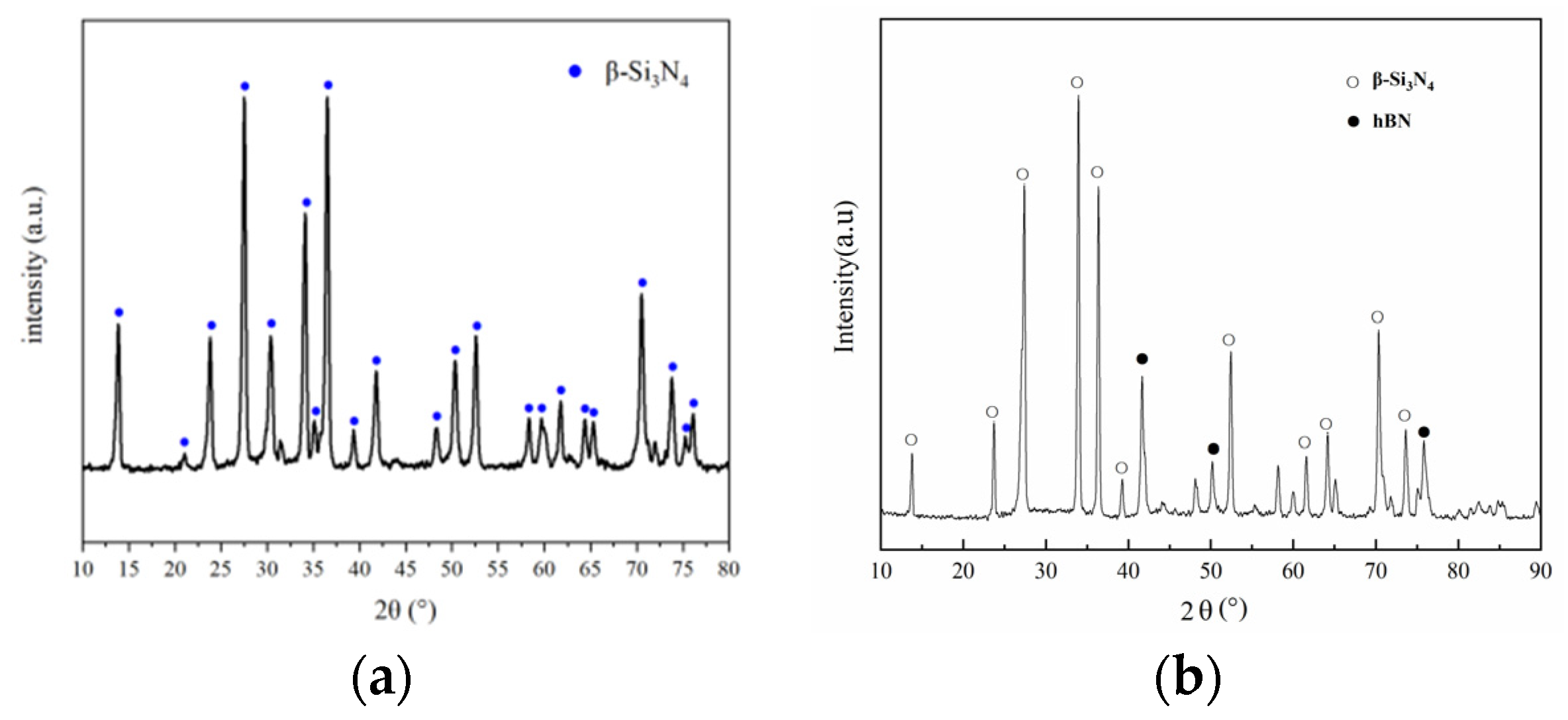

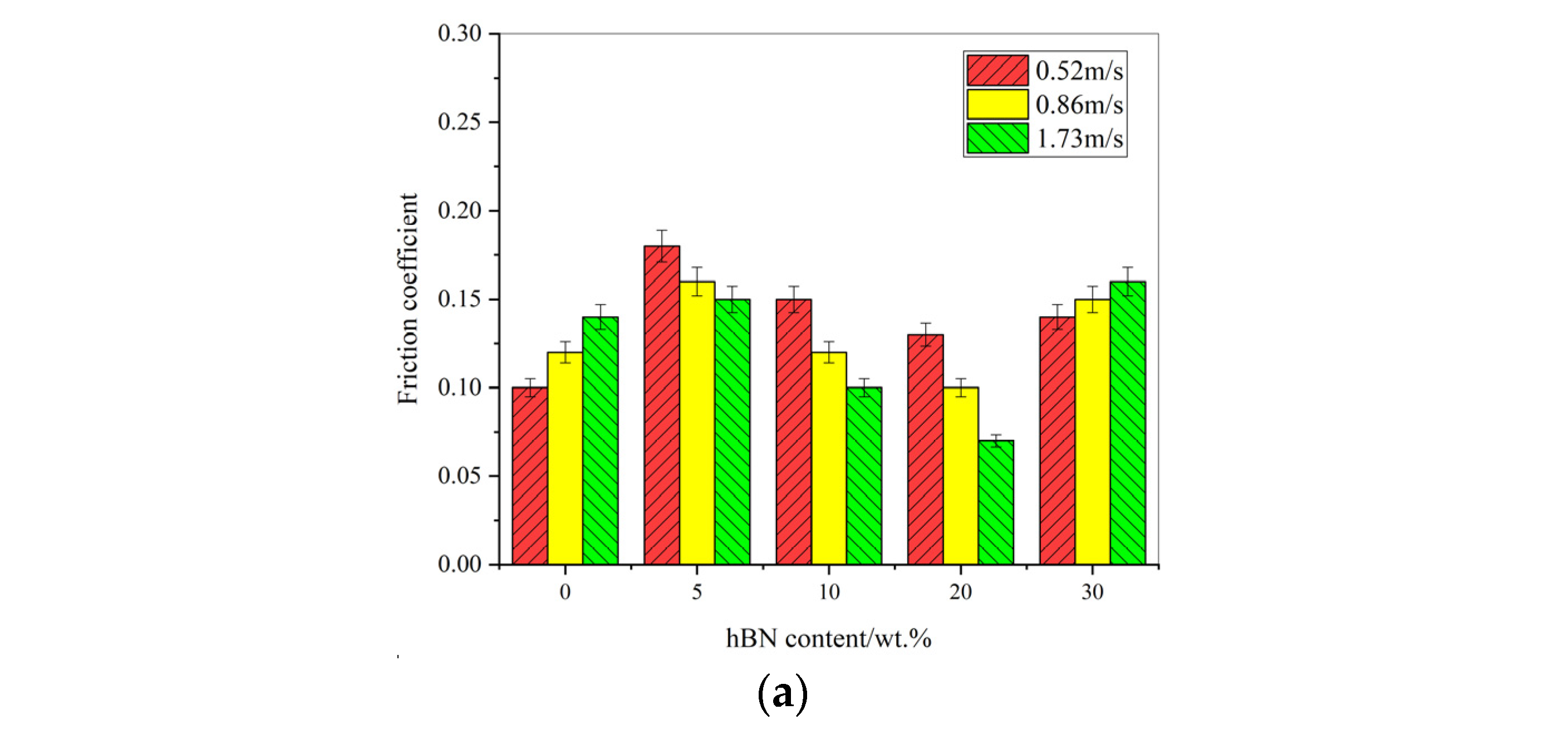
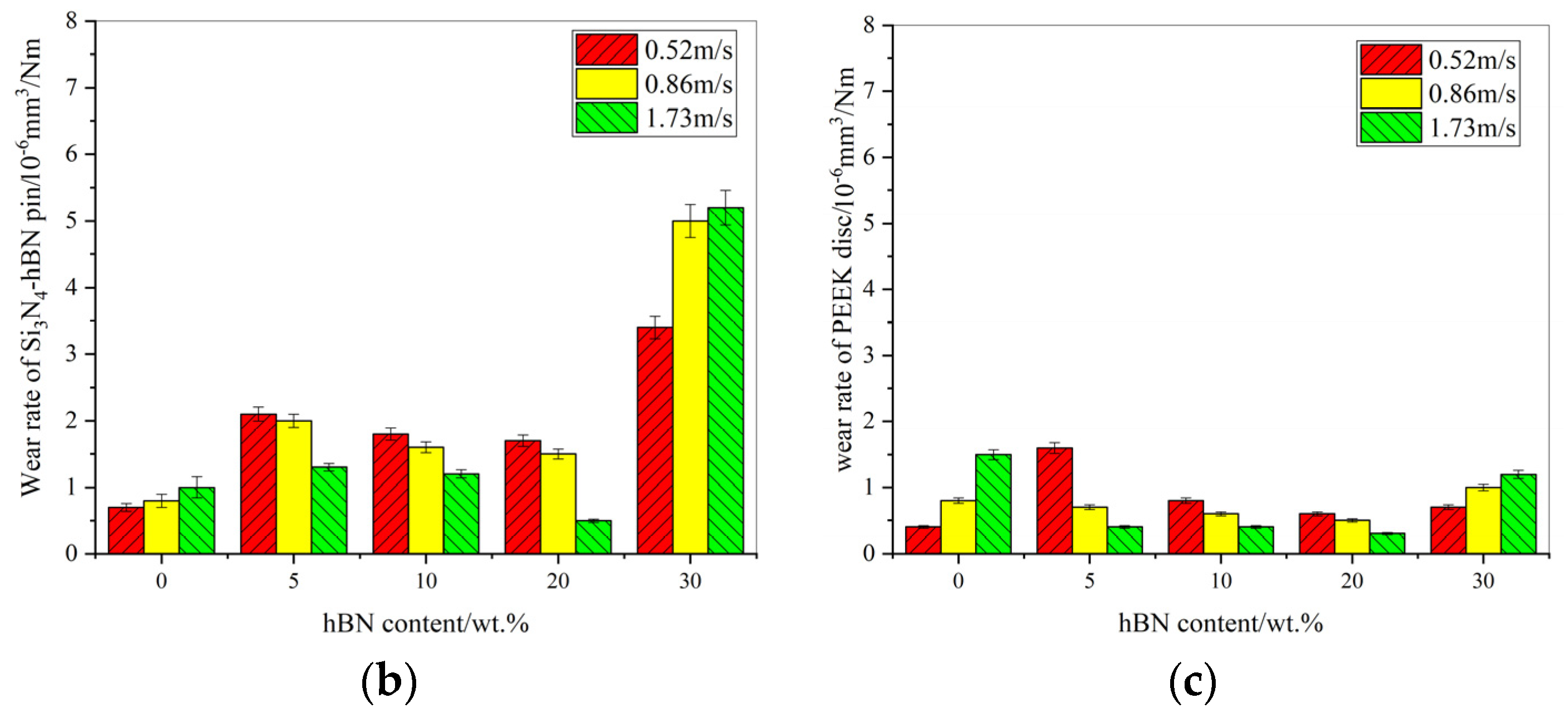
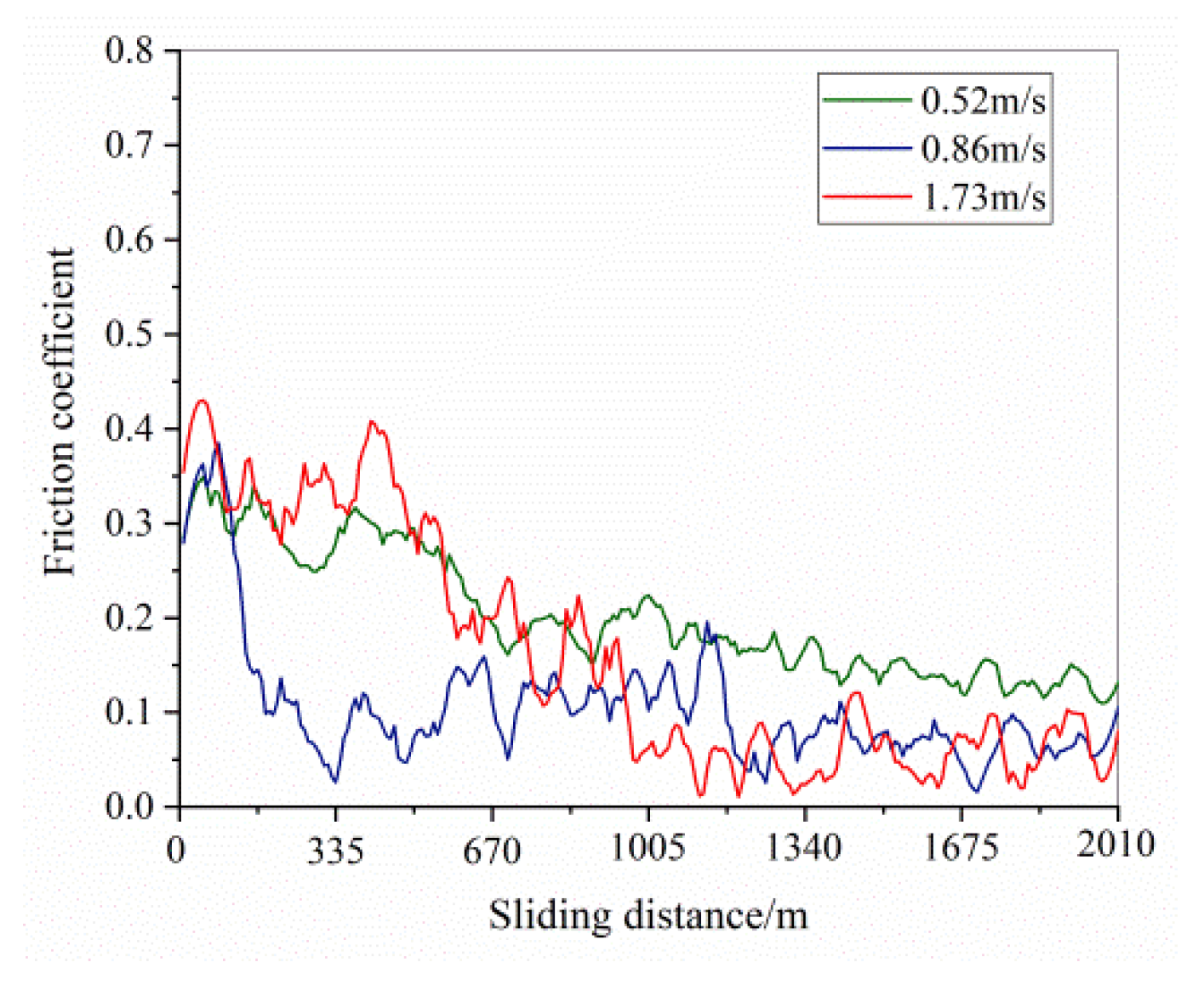
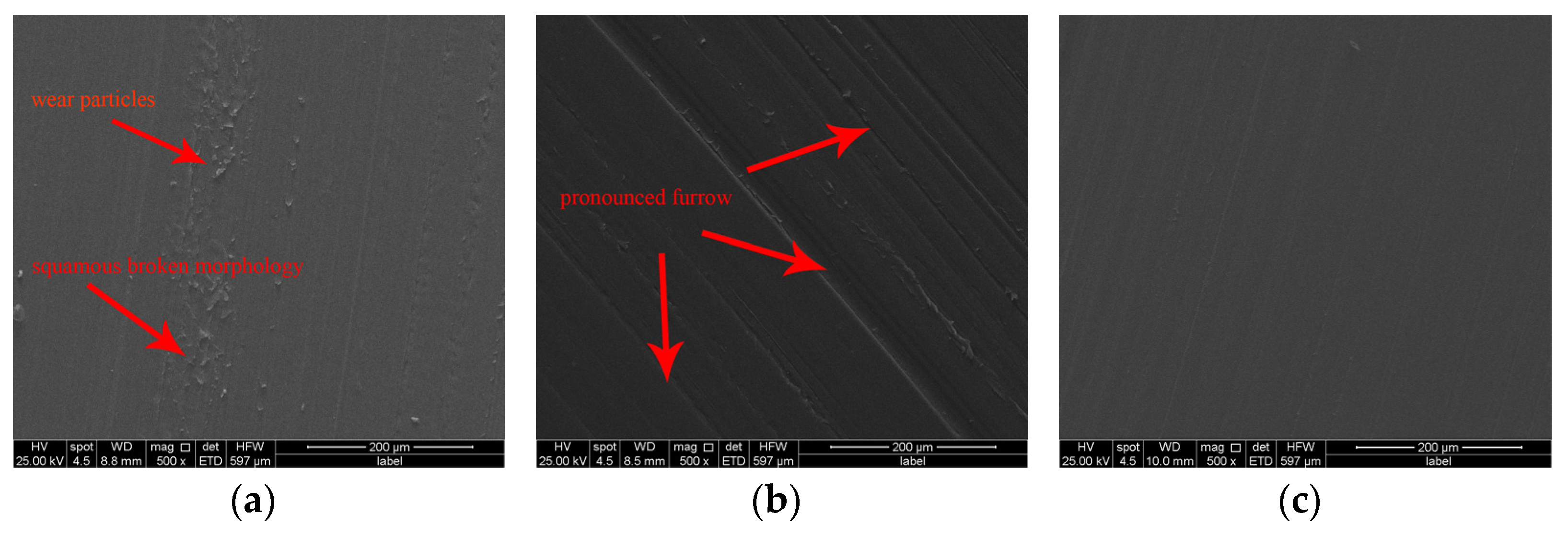

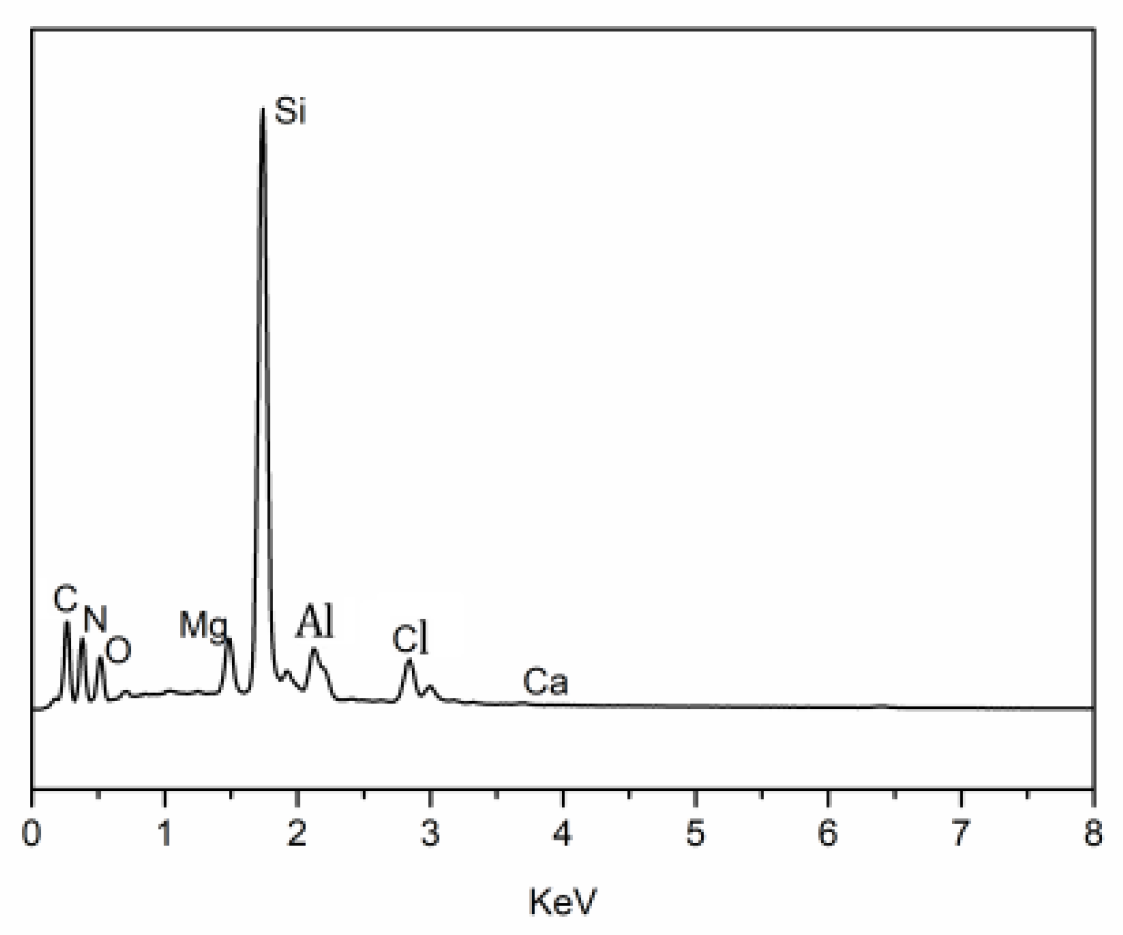
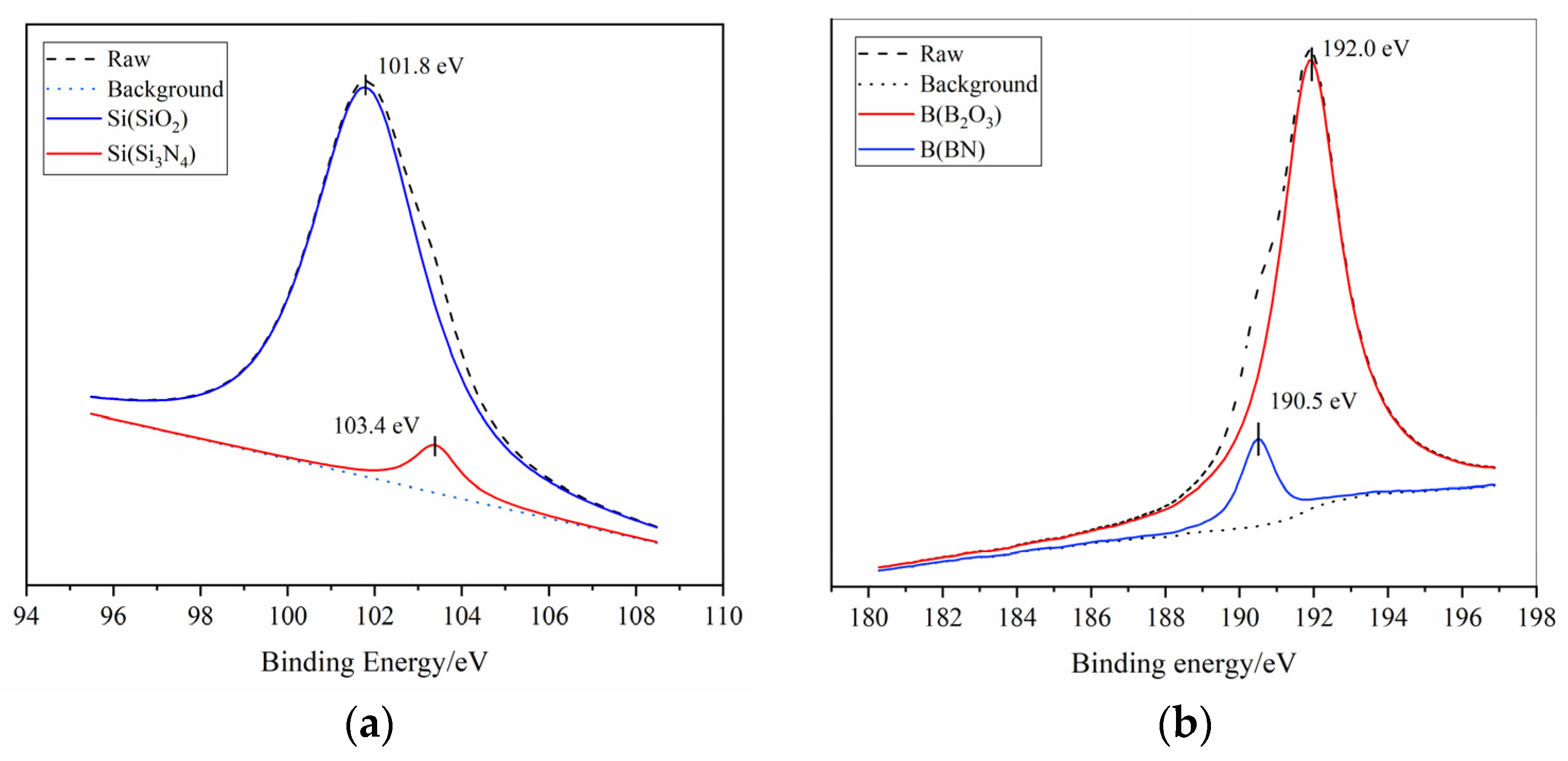
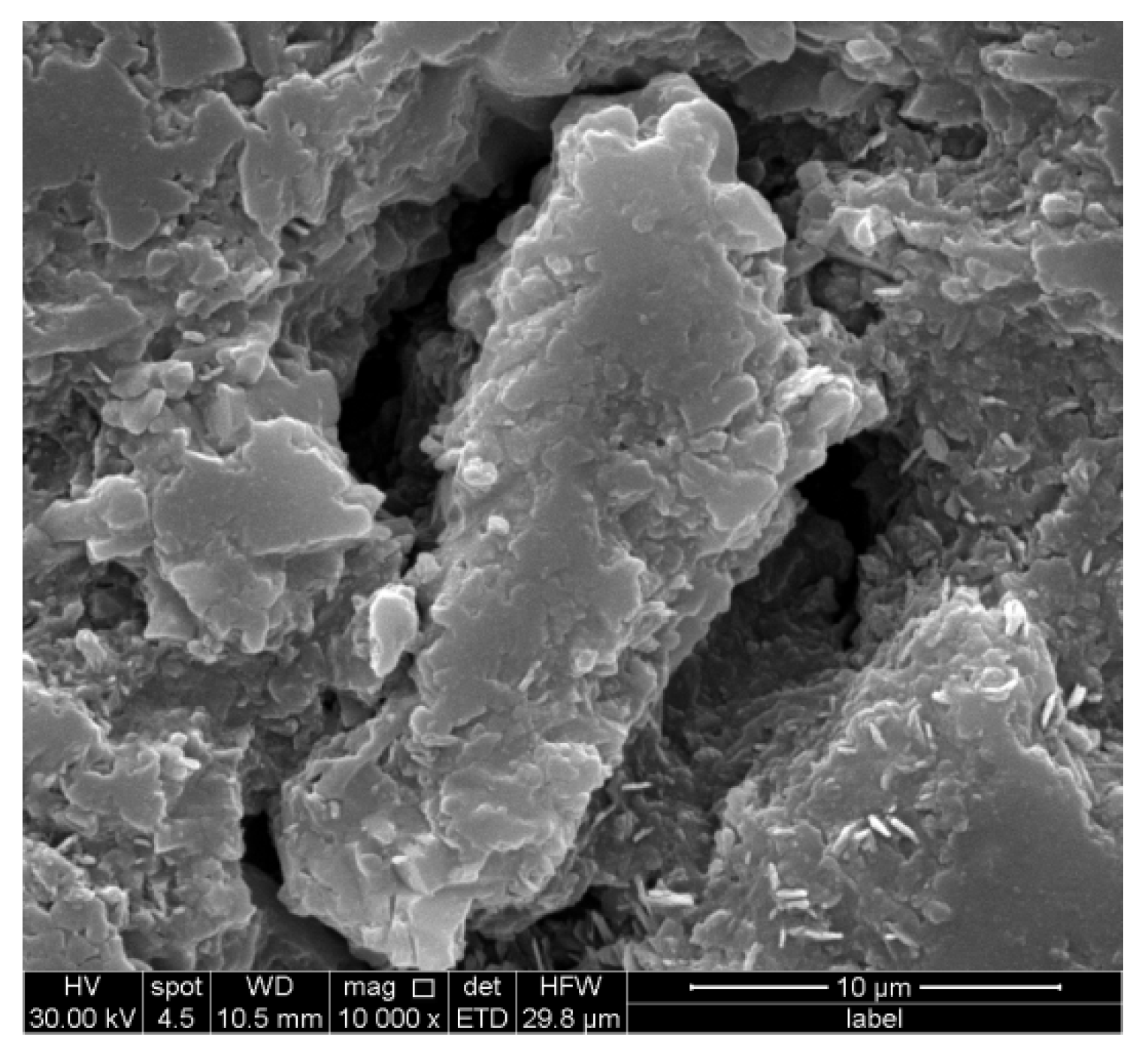

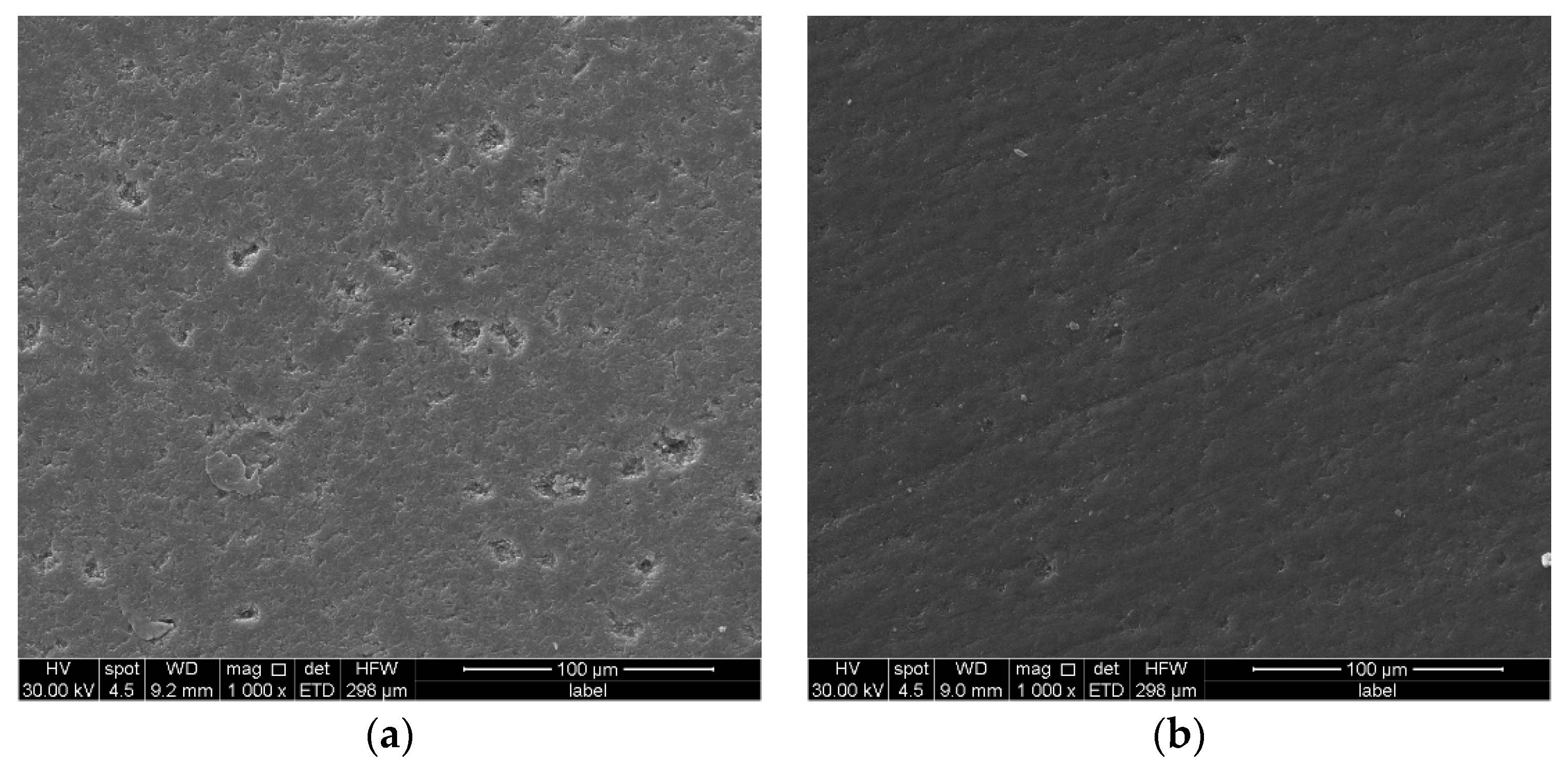
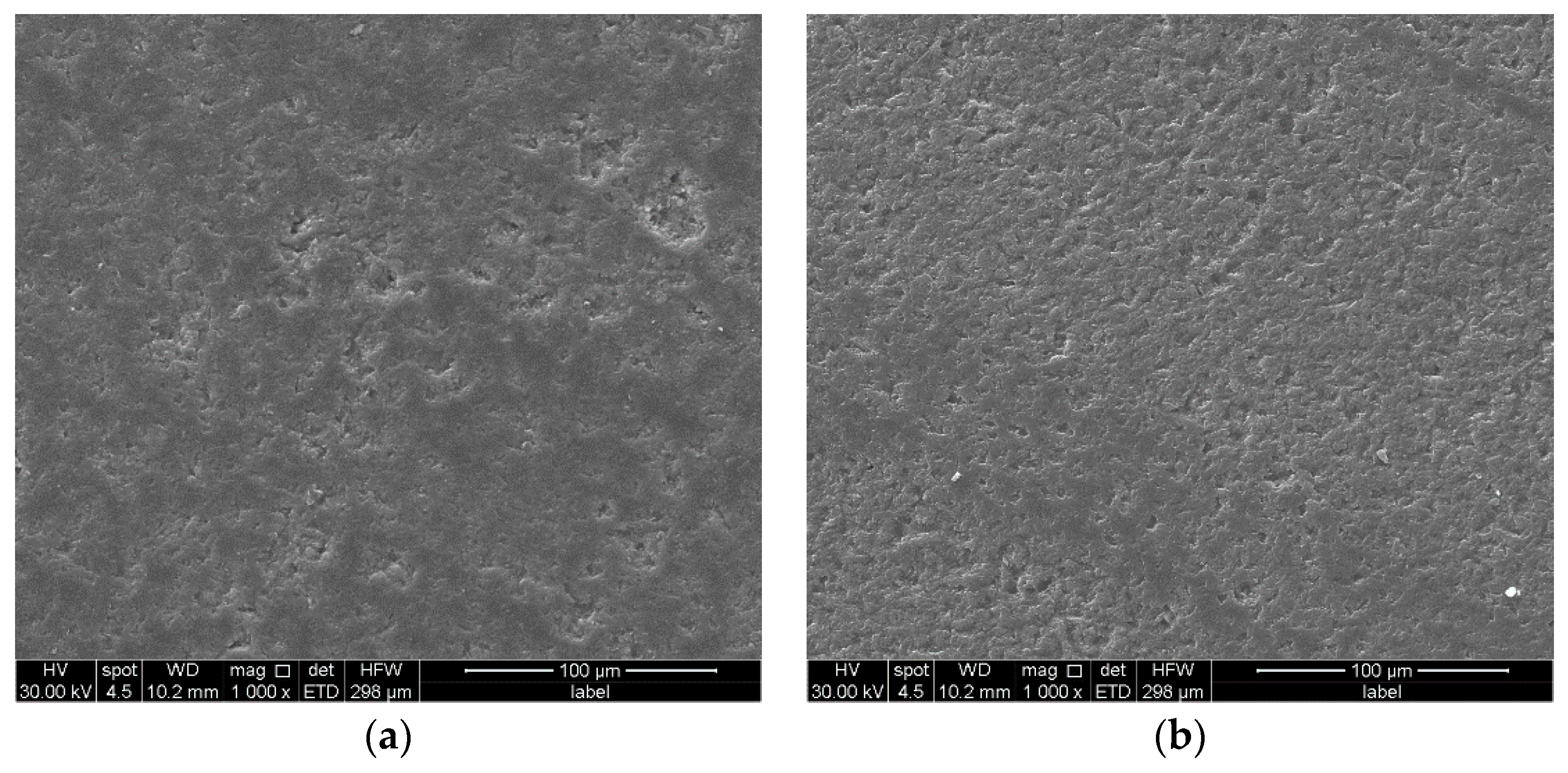
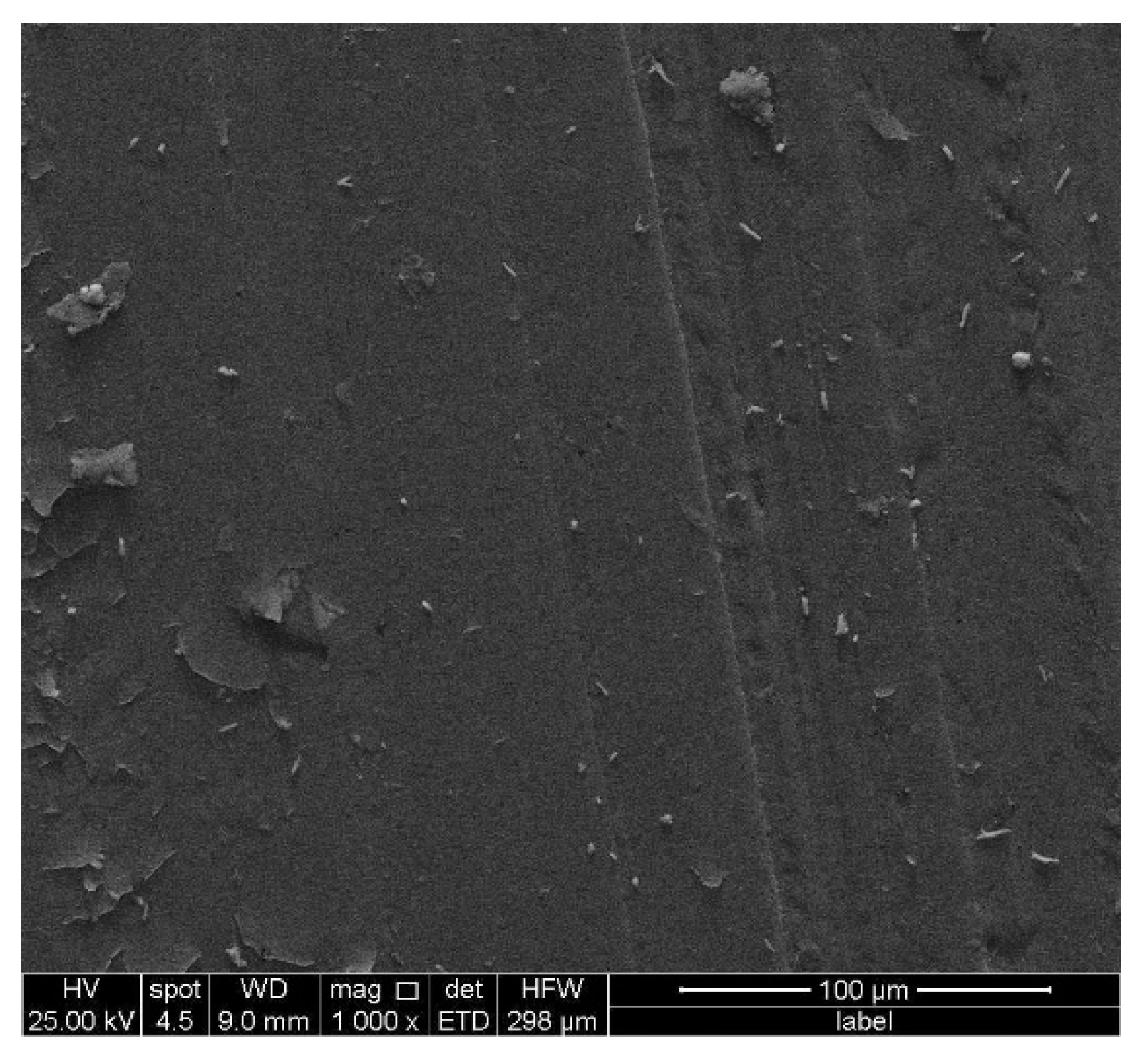
| Specimens | hBN Amount (wt.%) | Density (g/cm3) | Porosity (%) | Bending Strength (MPa) | Vickers Hardness (GPa) | Fracture Toughness (MPa·m1/2) |
|---|---|---|---|---|---|---|
| SN0 | 0 | 3.31 | 0.84 | 812 | 19.9 | 8.01 |
| SN5 | 5 | 3.17 | 0.90 | 758 | 19.6 | 7.80 |
| SN10 | 10 | 3.10 | 0.91 | 613 | 15.3 | 7.14 |
| SN20 | 20 | 2.97 | 1.04 | 541 | 9.3 | 5.97 |
| SN30 | 30 | 2.94 | 1.05 | 465 | 6.7 | 5.50 |
Publisher’s Note: MDPI stays neutral with regard to jurisdictional claims in published maps and institutional affiliations. |
© 2022 by the authors. Licensee MDPI, Basel, Switzerland. This article is an open access article distributed under the terms and conditions of the Creative Commons Attribution (CC BY) license (https://creativecommons.org/licenses/by/4.0/).
Share and Cite
Li, H.; Liu, X.; Zhang, C.; Jiao, X.; Chen, W.; Gao, J.; Zhong, L. Friction and Wear Properties of Silicon Nitride-Based Composites with Different hBN Content Sliding against Polyether-Etherketone at Different Speeds under Artificial Seawater Lubrication. Coatings 2022, 12, 411. https://doi.org/10.3390/coatings12030411
Li H, Liu X, Zhang C, Jiao X, Chen W, Gao J, Zhong L. Friction and Wear Properties of Silicon Nitride-Based Composites with Different hBN Content Sliding against Polyether-Etherketone at Different Speeds under Artificial Seawater Lubrication. Coatings. 2022; 12(3):411. https://doi.org/10.3390/coatings12030411
Chicago/Turabian StyleLi, Huaqiang, Xingwei Liu, Chen Zhang, Xiaoyu Jiao, Wei Chen, Jinghui Gao, and Lisheng Zhong. 2022. "Friction and Wear Properties of Silicon Nitride-Based Composites with Different hBN Content Sliding against Polyether-Etherketone at Different Speeds under Artificial Seawater Lubrication" Coatings 12, no. 3: 411. https://doi.org/10.3390/coatings12030411
APA StyleLi, H., Liu, X., Zhang, C., Jiao, X., Chen, W., Gao, J., & Zhong, L. (2022). Friction and Wear Properties of Silicon Nitride-Based Composites with Different hBN Content Sliding against Polyether-Etherketone at Different Speeds under Artificial Seawater Lubrication. Coatings, 12(3), 411. https://doi.org/10.3390/coatings12030411







